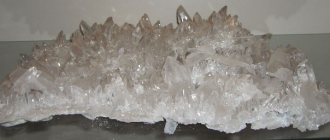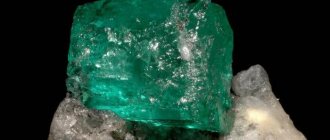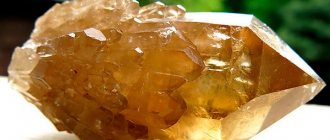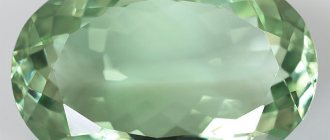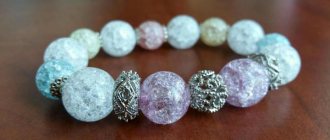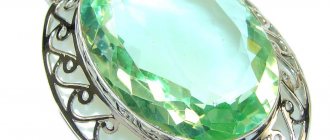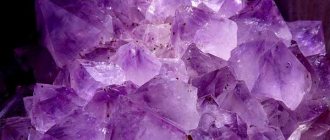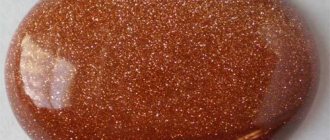Quartz is considered one of the most common minerals in nature. In addition, this stone is found in a large number of varieties that have certain properties. This mineral has been familiar to man since ancient times - tools and amulets were made from quartz. Today, quartz is used not only in the jewelry industry, but also in other sectors of the national economy. So what is quartz used for?
Quartz stone
Excursion into history
For a long time, only colorless and transparent specimens of this mineral were called quartz. Colored crystals were considered independent stones and had their own names.
Translated from German, quartz means “solid”.
People understood what quartz is not so long ago. The advent of advanced technologies has made it possible to determine that a number of minerals that are outwardly dissimilar to each other belong to the same group.
Due to the similar name, the crystal is often confused with quartzite. Quartzite stone contains quartz in its composition, but in addition to it there are other impurities. This is a very strong breed that is difficult to process. Its shades are a mixture of gray and white. Externally, the mineral is quite unattractive.
Quartz crystals were popular among different segments of the population. They were worn by rich and middle-income people. Although initially some species were used only by a select few. The stones were worn by priests, and alchemists and healers experimented on them. Over time, ordinary people were able to buy gems.
In the 20th century, it became possible to grow such crystals artificially. Crystals born in the laboratory differ from natural ones in appearance. They have very regular shapes and clear color transitions. But the beauty of these gems is empty: they do not know how to heal.
Crystallographic characteristics
Syngony. A higher temperature modification of β-quartz crystallizes in the hexagonal system, hexagonal-trapezohedral c. With. L66L2.
The modification of α-quartz, which is more stable at temperatures below 573 °C (at atmospheric pressure), crystallizes in the trigonal system, trigonal-trapezohedral c. With. L33L3. Space group P3121(D43) or P3221(D53) (right and left enantiomorphic modifications). a0 = 4.904, c0 = 5.397.
Crystal structure
Crystal structures are quite simple.
Crystal structure of β-quartz. In each SiO4 tetrahedron, two oxygen ions are located slightly higher, and the other two are located slightly lower than the silicon ion. Groups of tetrahedrons lie in three layers at different heights. Tetrahedra form spirals, each of which twists in the same direction. The so-called right and left quartz differ in that the inversion of these spirals occurs to the right or to the left. A rotation around the gear axis by 60° and a translation of one third of the height of the unit cell along the c axis leads to a coincidence with the previous position of the tetrahedra.
The low-temperature modification of α-quartz is only slightly different in its crystal structure from β-quartz. During the polymorphic transformation of a high-temperature modification into a low-temperature one, small displacements of the centers of silicon-oxygen tetrahedra occur, resulting in a compaction of the lattice and a decrease in its symmetry: six-axes turn into triple ones. In this case, the type of bond between tetrahedral groups does not change. During the transformation process, there are no changes in the directions of the spirals (to the right or to the left).
Where is quartz mined?
While the reserves of some minerals are being depleted, active mining is underway at other deposits. It is still too early to worry about the depletion of quartz deposits. The underground larder is full of superb specimens and comes from all over the world.
Where is the mineral quartz mined:
- Madagascar;
- Sri Lanka;
- Mexico;
- Uruguay;
- Brazil;
- Ukraine;
- USA.
Mining is carried out in several ways - open-pit and manual. But the industrial method still prevails. The occurrence locations of this rock are very diverse - mountains, plains, sea and river bottoms.
Main concentration areas in Russia:
- Yakutia;
- Caucasus;
- Chukotka;
- Ural.
Contrary to popular belief, unsuitable samples are more often found in natural conditions. Low-grade jewelry is made from them. Often such gems are left unprocessed and sold as “pocket” talismans.
Mineral deposits and processing
Quartz deposits are found on all continents. The rock occurs in mountains, plains, seas and rivers. Mining is carried out manually and in a quarry.
The largest deposits of ornamental and semi-precious stones:
- Brazil;
- Ukraine;
- Uruguay;
- Kazakhstan;
- Mexico;
- Madagascar.
In Russia, quartz deposits are located in Yakutia, the Urals, Chukotka, and the Moscow region.
Processing of the rock depends on the purpose of use. Large layers of ornamental quartz are almost not processed. They are given the correct shape and used in architecture.
Stone fragments are turned into quartz chips or dust used in industry.
Particularly beautiful samples are used in jewelry. Semi-precious quartz is cut with a brilliant cut. The rest are in the form of cabochons.
The cleaned stone decreases in size, but acquires a beautiful color.
Additional story about quartz from a stone specialist:
Physicochemical characteristics
Quartz is one of the most common minerals on earth. In terms of hardness, it is only slightly inferior to diamond. The stone is mostly transparent, but there are also opaque varieties.
Basic properties:
- quartz formula - SiO2;
- hardness - 7 points;
- fracture - conchoidal;
- shine - glassy or greasy;
- refractive index - 1.544;
- density - 2.6-2.65 g/cm³;
- cleavage - imperfect;
- transparency - transparent, opaque;
- melting point - 1700°C.
The crystal is included in many minerals as an additional impurity. It itself may also contain impurities - sometimes aluminum or iron is found in it. The “purest” variety is mountain quartz. It is a white transparent stone that looks like glass.
Colors and varieties of quartz
We have already found out that this is not one stone, but a whole group of minerals. This is why it is so difficult for ordinary buyers to understand what quartz looks like. After all, each species has its own characteristics. They differ in color, size, and pattern.
You can determine which is a fake and which is a real mineral only by learning the characteristics of a particular variety:
- Rock crystal is a colorless variety. Transparent crystals have inclusions in the form of cracks and bubbles.
- Rutile or “hairy” quartz. It can be confused with citrine. Most often found in golden and lemon shades, but there are also orange or black specimens. All gems have inclusions similar to a strand of women's hair - by this feature they can be easily distinguished from other minerals.
- Morion. A deep black stone, similar to charcoal, only shiny.
- Rose quartz. This stone does not have its own unique name; this does not spoil its beauty. The cloudy powder-colored crystal has white veins and looks beautiful even without cutting.
- Prase. A gem in green shades with varying degrees of transparency (up to almost transparent).
- Amethyst. In its classic form it is a violet-white mineral. But among amethysts there are specimens of lilac and almost black color.
- Tourmaline quartz. It is an unusual, milky-gray crystal with black inclusions in the form of shavings.
- Blue quartz is a mineral in blue or blue shades, which is also called sapphire. It is rarely found in nature, which is why it is very actively counterfeited. Most of these stones in the store come from the laboratory.
Artificial production of quartz mineral
Artificial quartz is well synthesized by the hydrothermal method, and for industrial applications artificial quartz is even more preferable than natural quartz, since it contains fewer impurities and is more homogeneous (this is especially true for quartz piezo-optical elements).
As for artificial precious quartz, here too artificial crystals have a number of advantages over natural ones, mainly due to the ability to give crystals any color, including green, which is very rare in nature, as well as blue and indigo, which are not found in natural conditions at all.
How to spot a fake
Gems from the quartz group are affordable for almost anyone. Yes, it makes no sense to fake them. But does this mean that there is no risk of buying a fake? Alas!
Real stone contains various inclusions and has cracks on the surface.
Manufacturers do not miss the chance to profit from consumers even in small things. How to protect yourself? Keep your eyes open and don’t buy jewelry at the market.
How to test quartz:
- Each type has its own palette of shades and patterns. But all these stones have something in common - natural imperfection. The uniqueness of the pattern and unevenly placed inclusions is what distinguishes a natural mineral from a synthetic one.
- Natural quartz is, of course, not a diamond, but it has a fairly high hardness. Artificial stone will immediately react to an attempt to scratch its surface with a sharp object. Nothing will happen to a real mineral.
- This very simple test will help determine the authenticity of the stone. Just hold it in your hand and wait for a while. Did the crystal heat up quickly? Do some more tests, it might be fake.
It is difficult to focus on cost, because it will differ for different types of mineral. If it is not just a pendant, but a full-fledged decoration, then the price will also include the price of the metal and the work of the craftsman. The only thing I can advise is not to buy something that is outright cheap.
Methods to confirm the natural origin of quartz
To distinguish natural quartz (quartz of natural origin) from artificial or glass (since the most rare varieties of quartz are often counterfeited), it is necessary to run a sharp or blunt object, such as a knife or stone, across the surface of the quartz, and if the quartz is of natural origin, then traces will not remain on its surface. Another way is if you lick the surface of a natural gem and artificial quartz with your tongue, then the surface of the gem will always feel colder. There are other methods, but they are usually used by jewelers.
Areas of use
The hardness of the mineral, its diversity and a large supply of deposits have contributed to the spread of the stone in various fields of activity.
The best samples are used by craftsmen to create jewelry. Men's, women's, unisex style jewelry.
The main use of quartz is jewelry.
Gem jewelry:
- earrings (stud earrings, clip-on earrings, pendant earrings);
- pendants (pendants, amulet);
- necklace, necklace;
- brooches or pins with mini pendants;
- rings and rings;
- bracelets (classic single-strand versions and unusual, fashionable now, shamballa);
- cufflinks
Products made from quartz can serve not only to decorate the body. Jewelry made from it is often worn as talismans.
The function that such an amulet will perform depends on the type of quartz. Some stones develop clairvoyance, others protect against energy vampires, and others bring good luck.
In addition to jewelry, there are also special magical attributes. They are not worn on the body, used only during ceremonies and rituals. Surely you've heard about the seers' ball? This is one of the most famous magical attributes, even mentioned in the fairy tale about the famous wizard with a scar on his forehead. It is made from rock crystal, which we already wrote about above.
Quartz also found its place in the interior. Figurines and ashtrays are made from solid pieces; objects made from other materials are inlaid with smaller pieces. Furniture and picture frames, chandeliers, candlesticks, clocks, vases, dishes and writing sets are decorated with gems.
After the discovery of the piezoelectric effect, the stone was used for a long time exclusively for military needs. Scientists who discovered this property proposed using it to detect enemy submarines using ultrasound.
Over time, the scope of use has expanded. Optical instruments and radio equipment began to be made from the mineral. Today, the ceramic and glass industry can no longer do without it.
Care of quartz products
This mineral cannot be called capricious. The luckiest person was the one who bought a solid, undrilled stone or purchased a pendant. In this case, care will be minimal. It’s a little more difficult for jewelry owners. They need to pay attention to washing the item and cleaning the metal when it becomes tarnished.
Protect jewelry with stones from aggressive chemicals.
We will not touch on the nuances of caring for different metals; we will focus on how to handle the crystal itself:
- for cleaning, you can use hand soap - solid or liquid (when using solid soap, rub your hands with soap, not the jewelry, otherwise soap particles will get stuck in the cavities);
- stones of this family are not afraid of temperature changes, but using warm water simplifies the “washing” process - the dirt dissolves faster;
- It’s okay if dishwashing detergent gets on the gem, but it’s better to keep it away from aggressive chemicals (stove, bathtub cleaners).
Do you use a mineral as an amulet or talisman? Then he definitely needs energy cleansing. Experts in the field of magic recommend reading special spells over the stone, cleansing it with fire or salt.
Care instructions
Real citrines are not damaged in daily use, but after heat treatment they become more fragile. They sometimes crack and scratch. Such stones require careful handling. They must be protected from falls and direct sunlight so as not to fade.
To remove dirt, it is recommended to use a soap solution and a soft brush. You can use ordinary clean water. After cleansing, the stone is wiped with a dry soft cloth and stored in a bag made of natural fabric. It is advisable to keep it separate from other jewelry.
Healing properties
The main difference between natural minerals and artificial ones is their energy content. Stones formed in natural conditions absorb the power of the earth and the energy of the elements. But laboratory-made gems have no medicinal properties. The ancient Greeks knew that quartz could provide health benefits.
Treatment with a stone involves its contact with the skin.
Healing properties and importance of quartz for humans:
- has shown effectiveness against inflammation and dermatitis;
- heals wounds, bruises, hematomas;
- strengthens the nervous system;
- helps to improve sleep patterns;
- increases concentration, strengthens memory;
- some types are used to treat addictions;
- normalizes blood pressure;
- used to alleviate the condition of respiratory tract diseases.
It is difficult to talk about all the properties of the mineral; it has too many varieties. Many of them help against several diseases at once, treating in different directions. But usually a stone works best on one thing.
Before buying a piece of jewelry or amulet made of quartz, find out why this particular subtype is useful. A pink and black stone will have different properties, although in fact both belong to the same group.
What should quartz treatment be like? Regular. There is no point in wearing jewelry once a month, then there will be little benefit. Any litotherapist will tell you this. But it’s important not to overdo it here. Some stones have too strong an influence on the human biofield; they are allowed to be worn for no more than a few hours a day without harm to health.
The traditional method of treatment involves contact of the stone with the skin. It is worn on a cord or chain, attached to a bracelet or put on a ring with it.
Stone cost
Citrine is a rare type of quartz, which is why it is valued by collectors and jewelry makers. However, this only applies to natural specimens. For ordinary buyers, it is difficult to distinguish fired minerals from untreated specimens. They are quite affordable in price. The price per carat of yellow crystals is at the level of 550-560 rubles.
Several factors influence the cost:
- weight;
- color;
- saturation;
- degree of purity.
The orange-colored Madeira is the most valued among the processed species. Most often, buyers purchase smoky quartz that has undergone a firing process. Absolutely transparent rare specimens are given a diamond cut, while the rest use the cabochon or flat method.
The magical power of the gem
The magical properties of quartz, as well as the healing ones, differ for each variety. It is believed that magical properties are especially strong in translucent and transparent minerals. By choosing the right crystal, you can dramatically change your life and improve your karma. That's why you need to approach this matter wisely.
General magical properties:
- Stones of this group can bring good luck and creativity. People of creative professions buy quartz figurines so that inspiration comes to them more often. The pink crystal has this feature.
- Gems of pink shades are also used in love magic. The energy of the stone puts you in a romantic mood, helps you reveal your feelings, and teaches you to show care towards your loved ones. For shy people this is what they need.
- A completely transparent and colorless variety of the mineral is used by diviners. The stone is worn on oneself to enhance the prophetic gift. Glass balls are also made from it, helping to look into the future.
- Amethyst has a bad reputation among the people. And it’s not just the sad legend associated with this stone. It is used for love spells, so esotericists recommend not accepting amethyst items from people you don’t like.
- Like rock crystal, citrine helps to accumulate magical power. Wearing such a talisman, the practitioner of magic feels more confident and feels a surge of strength.
Beginners in magic miss many obvious things. For example, they forget about cleaning the talismans - they become “clogged” and begin to work to their detriment. As a result, the amulet flies into the trash bin, and the practice itself is abandoned. This is easy to avoid - you just need to cleanse the stone of negativity in time.
Observe how your life has changed after purchasing the amulet. Are there any positive changes? Or more negative? Has it affected your well-being? Only small changes can happen in a short period of time, but you need to pay attention to them, because big changes always start with small ones.
Properties and uses of the mineral
Quartz stone is used in various industries.
- It is a glass-forming oxide and is therefore used to make glass.
- Some types of stone are distinguished by their beauty, and therefore are used in the jewelry industry. Quartz can be either ornamental or semi-precious.
- The mineral has antibacterial properties, so it is used to make medical quartz lamps.
- The mineral is used for baths and saunas because it can withstand high temperatures well. And if you splash water on a hot stone, the resulting steam has a beneficial effect on the respiratory tract.
- Black quartz is used to decorate an aquarium. With this stone, the water remains clean for a long time. Black quartz sand is sprinkled on the bottom of the aquarium and it resembles the real seabed.
Physicochemical characteristics
The word "quartz" comes from the ancient German "twark", which meant "solid". This is a really hard mineral, ranking 7 on the Mohs scale. Slightly harder than quartz, Paraiba tourmaline has a rare blue color. He is given 7.5 units on the scale.
All types of quartz have the same chemical formulas - SiO2, silicon oxide. Depending on the type of stone, atoms of copper, iron, zinc, and fluorine can be added to it.
The colors of the mineral are very diverse. Pure quartz is almost transparent, colorless. Other colors are determined by inclusions of other minerals and metals.
A line drawn on a stone with a sharp object is white. The surface has a glassy, sometimes greasy sheen. The fracture surface is conchoidal. Imperfect cleavage means that when a stone is crushed, perfect fragments cannot be obtained.
The density is 2.6 grams per cubic centimeter. The crystal lattice, or stone system, is trigonal. This means that the atoms are arranged in regular triangles.
The structure of quartz varies depending on the rock where it is formed.
- The quartz crystal is shaped like a hexagonal prism. They can be long or short.
- In igneous rocks, crystals form irregularly shaped grains, often welded to other minerals.
- In sedimentary rocks, crystals occur in the form of veins, quartz geodes, and fragments.
Quartz dissolves in hydrofluoric acid and alkalis. The melting point of quartz sand is from 1713 to 1728 degrees. Has dielectric properties.
Medicinal properties
Pure quartz, free of impurities, has the greatest healing properties. The mineral has a beneficial effect on the respiratory system, nervous system and skin.
For treatment, water infused with the mineral is used. To do this, the stone is placed in boiled water and left for a day. Use charged water to wash or take orally.
Washing with quartz water improves the condition of the skin, making it soft and elastic. Acne disappears, wounds and abrasions heal faster. Ingestion helps heal inflammatory processes.
Magic properties
Pure quartz also has magical properties. The stone is used by clairvoyants and soothsayers. It helps predict the future. Nugget balls are conductors to the other world.
Colored varieties of the mineral also have magical abilities used in various areas of life.
- Ruby gem is a love talisman. It is used for rituals and love spells.
- Rauchtopaz is a talisman for traders and company owners. It helps its owner make strategic decisions and conclude successful deals.
- Ice quartz is a stone for meditation. It cleanses the soul and provides clarity of mind.
- Amethyst serves as a truth serum. It forces a person to say only truthful things. Amethyst is also capable of detecting poison - it becomes cloudy when immersed in a poisonous liquid.
Each type of mineral has its own magical properties, each crystal has its own aura.
When choosing an amulet, you need to carefully study the features of the stone, based on your desires.
The compatibility of stones is determined taking into account the elements. Most varieties of the mineral belong to Earth or Air. They are compatible with emerald, moonstone, sapphire, aquamarine, ruby, jade.
Who is the stone suitable for according to their zodiac sign and name?
Quartz is most compatible with Gemini, Libra and Aquarius. The gem protects representatives of these signs from evil, brings them good luck and helps them discover their talents.
Moderate compatibility is observed with Scorpio, Cancer and Pisces. The mineral brings happiness to these signs. For Taurus, Leo and Capricorn, the gem protects against bad habits and helps fight addictions.
The stone is contraindicated for Sagittarius and Aries. At best it will not have a positive effect, at worst it will bring failure.
Amulets are selected depending on the name:
- soft and gentle Alina, the raspberry-colored mineral will give love, tenderness and peace of mind;
- Amethyst is suitable for Andrey, which will help cope with nervous tension;
- rauchtopaz will protect Victor from addictions;
- Pure rock crystal will suit Evgenia;
- Citrine will help improve George’s leadership qualities;
- the hairy one will help Nadezhda find love.
The greatest effect of the mineral is observed when the name and zodiac sign coincide.
Who is suitable according to their zodiac sign?
Take your talisman purchase seriously. Some stones get along with certain signs and don't get along with others, while others suit everyone. And still others do not have the most useful good energy. You need to find yours.
Zodiac properties of quartz:
- Transparent quartz, also known as rock crystal. A good talisman for Pisces and Libra. Also suitable for Leos and Taurus. The stone will make these signs more successful (in all areas at once).
- Pink. Another talisman for Libra and Taurus. These signs lack calmness and gentleness. A stone of a romantic shade will fix this.
- Smoky quartz. Recommended as a talisman for Virgos and Capricorns. But under one condition, almost anyone can wear it (if you decide to get rid of some bad habit).
- Citrine. This light solar stone will become an amulet of happiness for Gemini. It will bring wealth to Virgos, and will help Libra in career growth.
What to do if the gem you like does not suit your horoscope? Don't panic! Remember that these are just recommendations. Do you want to buy some jewelry? Buy if you feel that this is 100% your gem.


